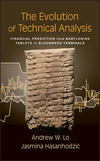The Evolution of Technical Analysis
 The Evolution of Technical Analysis: Financial Prediction from Babylonian Tablets to Bloomberg TerminalsISBN: 978-1-57660-349-9
Hardcover
224 pages
September 2010
This is a Print-on-Demand title. It will be printed specifically to fill your order. Please allow an additional 10-15 days delivery time. The book is not returnable.
Learn more about this book
|
|||||||
The Evolution of Technical Analysis
Technical analysis, which seeks to divine trends, reversals, cycles, and other predictable patterns for the purpose of forecasting prices, has been marred by common misconceptions likening it to gambling or magic and dismissed by many as “voodoo finance.” In THE EVOLUTION OF TECHNICAL ANALYSIS (Wiley; September 2010; $29.95; 978-1-57660-349-9; Hardcover), Andrew Lo, the director of MIT’s Laboratory for Financial Engineering, and coauthor Jasmina Hasanhodzic examine the origins and development of this mysterious “black art.”
The authors trace its evolution from the ancient world to the rise of Wall Street, presenting such fascinating information as:
- Ancient Babylonians would methodically record, often intraday, the prices of various commodities, but they would also assign those same commodities to the astrological regions of Pisces and Taurus, depending on whether they were bullish or bearish.
- The prevalence of market speculation in Ancient Greece led to the development of methods for using past prices and timely news to forecast future prices. Adaptive Athenian traders would change their strategies rapidly according to price fluctuations and news, such as immediately redirecting their ships upon hearing that grain prices have changed.
- In addition to logical lists of weights, measures, and exchange rates, medieval merchant manuals might also contain lengthy astrological appendixes which advised their readers to buy, sell, or begin anything new when they are in the region of Virgo.
- Christopher Kurz, a 16th century Antwerp trader, claimed to be able to forecast prices on commodities up to 20 days in advance using his technical trading system based on back-tested astrological signals.
- Also in the 16th century, Chinese merchant manuals taught their readers to predict changes in the price and availability of goods based, in part, on market cyclicality, and the Munehisa Homma developed the Japanese version of technical analysis based on candle charts, which remains popular worldwide to this day.
After exploring the roots of technical analysis in the Ancient World and the Middle Ages and its development in later centuries, the book examines Charles Dow’s work, which became the basis for modern technical analysis. In the late 19th century, it was the American rather than European markets that drove progress and innovation in the financial world, including the stocks ticker, the telegraph, and the telephone. It was during this period that Charles Dow started publishing his Dow Jones Industrial Average—the average price of a dozen most active stocks on the New York Stock Exchange—as an objective barometer of the stock market and the economy.
Dow argued that stock speculation is far removed from gambling, for it is based on the perception of a stock’s value and of the underlying market movements. “The market is not like a balloon plunging hither and thither in the wind,” Dow used to say. Rather, “It represents a serious, well-considered effort on the part of far-sighted and well-informed men to adjust prices to such values as exist or which are expected to exist in the not too remote future.”
The principles on which the now intricate field of technical analysis is built have remained unchanged since the time of Charles Dow and his immediate successors during the first half of the 20th century. According to those principles, markets move in trends, some major, such as bull and bear markets, lasting for years, other minor, often over in a day, but all deemed persistent in their own timeframe.
However, the techniques have become increasing sophisticated. Andrew Lo and Jasmina Hasanhodzic review the tools technicians use to recognize market developments and discuss how the changes on Wall Street in the second half of the 20th century have led technicians to reinterpret their craft. They also explore the academic approaches to randomness and how their proponents may be marginalizing the followers of technical analysis.
The authors conclude that while technical analysis has languished for too long in the murky waters of part art and part science, it is finally starting to develop a more rigorous approach. “Although the fortress walls separating technicians from the adherents of modern finance still stand tall, they are not insurmountable, and we hope that the recognition of the thousands-of-years-long legacy of financial markets will awaken the skeptics and open the door for the dialogue between the two communities to begin.”
From ancient roots in Babylonian price records, Greek market sentiment indicators, and Roman seasonality patterns to Dow theory and present day technical analysis, THE EVOLUTION OF TECHNICAL ANALYSIS demonstrates how, despite the distance created by continents and millennia, the market wisdom of Charles Dow is astonishingly similar to that of his predecessors. Such similarities reveal technical analysis as a truly universal phenomenon and highlight how deeply ingrained it is in human psychology to ride and reinforce the trends, and reason in technical terms.




